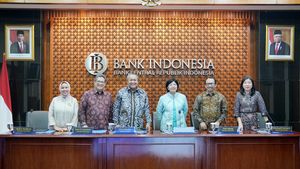JAKARTA - The monetary authority of Bank Indonesia (BI) reported that Indonesia's foreign debt at the end of April 2022 was recorded at US$409.5 billion, down from the previous month's position of US$412.1 billion.
On an annual basis, the position of external debt in April 2022 contracted 2.2 percent year on year (yoy), deeper than the contraction in the previous month of 1.0 percent.
Head of the BI Communications Department Erwin Haryono said the development was mainly due to a decline in the position of public sector external debt (government and central bank).
"The decline in the government's foreign debt occurred due to several series of Government Securities (SBN) maturing in April 2022 and a shift in the placement of funds by non-resident investors (capital outflow) in line with the high uncertainty in global financial markets," he said in a press statement on Thursday. Wednesday, 15 June.
In detail, Erwin explained that the government's external debt in April was 190.5 billion US dollars. This figure is lower than the position of external debt in March which amounted to 196.2 billion US dollars.
"The loan component also decreased on a net basis, as loan repayments were higher than loan withdrawals to support the financing of priority programs and projects," he said.
Meanwhile, private external debt grew slightly compared to the previous month to USD 210.2 billion. It was stated that this development was contributed by non-financial corporations, especially in line with the issuance of global corporate bonds in the mining and quarrying sector.
"The structure of Indonesia's external debt remains healthy, supported by the application of the precautionary principle in its management," he stressed.
In general, Indonesia's external debt in April 2022 remained under control, as reflected in the ratio of Indonesia's external debt to Gross Domestic Product (GDP) which was maintained at around 32.5 percent or decreased compared to the ratio in the previous month of 33.8 percent.
In addition, Indonesia's external debt structure remains healthy as indicated by the dominance of long-term liabilities with a share of 87.5 percent.
“In order to maintain a healthy structure, Bank Indonesia and the government continue to strengthen coordination in monitoring the development of external debt, supported by the application of prudential principles in their management. The role of external debt will also continue to be optimized in supporting development financing and encouraging national economic recovery by minimizing risks that can affect economic stability," concluded Erwin.
The English, Chinese, Japanese, Arabic, and French versions are automatically generated by the AI. So there may still be inaccuracies in translating, please always see Indonesian as our main language. (system supported by DigitalSiber.id)













